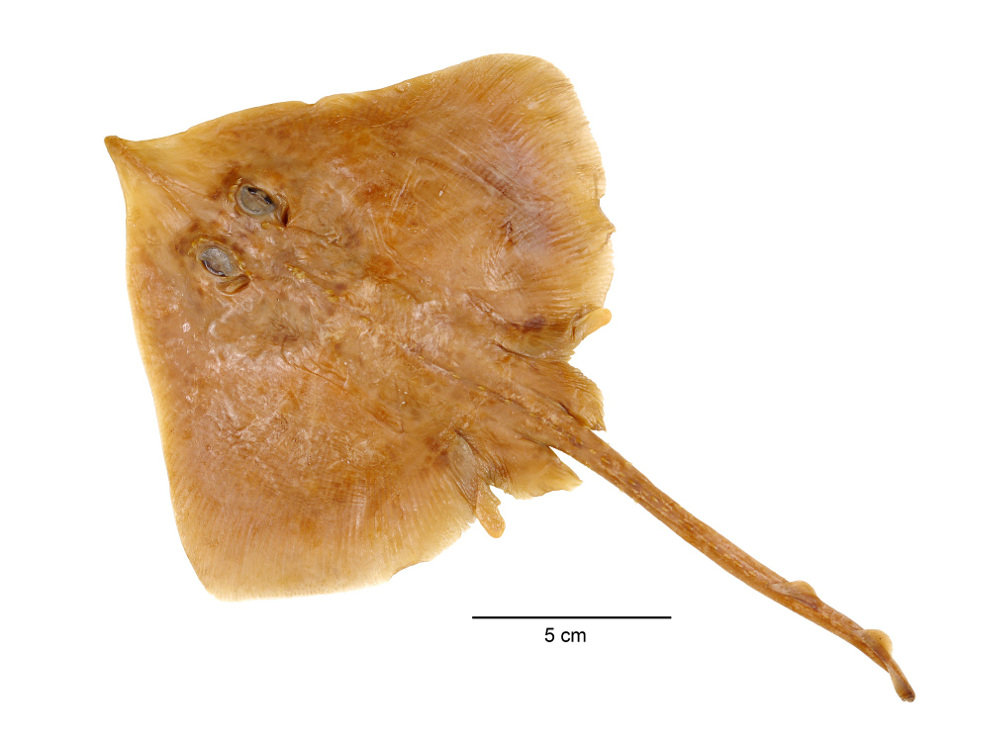Okamejei ornata
Weigmann, Stehmann & Thiel, 2015
Ornate Skate
Classification: Elasmobranchii Rajiformes Rajidae
Reference of the original description
Okamejei ornata n. sp., a new deep-water skate (Elasmobranchii, Rajidae) from the northwestern Indian Ocean off Socotra Islands. Deep Sea Research Part II: Topical Studies in Oceanography, 115, 18–29
Okamejei ornata n. sp., a new deep-water skate (Elasmobranchii, Rajidae) from the northwestern Indian Ocean off Socotra Islands. Deep Sea Research Part II: Topical Studies in Oceanography, 115, 18–29
Types
Okamejei ornata
Holotype: ZMH: 25885; Paratype: CSIRO: H 7369-01; MNHN: 2012-0267; ZMH: 25886; ZMH: 25887; ZMH: 25888; ZMH: 25889; ZMH: 25890; ZMH: 25891; ZMH: 25892;
Okamejei ornata
Holotype: ZMH: 25885; Paratype: CSIRO: H 7369-01; MNHN: 2012-0267; ZMH: 25886; ZMH: 25887; ZMH: 25888; ZMH: 25889; ZMH: 25890; ZMH: 25891; ZMH: 25892;
Description :
Citation: Okamejei ornata Weigmann, Stehmann & Thiel, 2015: In: Database of modern sharks, rays and chimaeras, www.shark-references.com, World Wide Web electronic publication, Version 12/2025
Please send your images of "Okamejei ornata" to info@shark-references.com

Okamejei ornata, paratype MNHN 2012-0267, juvenile male 247 mm TL; © Dr. Simon Weigmann, Center of Natural History, Hamburg, Germany

Okamejei ornata, paratype MNHN 2012-0267, juvenile male 247 mm TL; © Dr. Simon Weigmann, Center of Natural History, Hamburg, Germany
Common names
Ornate Skate
Ornate Skate
Short Description
Orignal diagnosis of WEIGMANN, STEHMANN & THIEL, 2015 [22623]: A species of the genus Okamejei with disc rhombic to evenly inverse heart-shaped (in adult male), with angled outer corners, and with body length to mid-vent shorter than tail length from mid-vent. Preorbital snout length 13–15% and distance between first gill slits 15–16% of TL. Orbits large, horizontal diameter 1.1–1.4 times interorbital width. Young specimens with 1–3 rows of tail thorns, adults with 3–5; more than two interdorsal and nuchal thorns. Dorsally, largely smooth, but snout tip prickly; with growth, dermal denticles also on anterior margins of disc and inner posterior pectorals, as well as ventrally on snout and anterior margins of disc. Ventral snout tip blackish, especially in young specimens. Dorsal ground color ocher, anterior snout dusky. Dorsal pattern on disc and pelvic fins consisting of variable dark brown spots encircled with beige pigment and arranged into rosettes. Ventral pores few, tiny, and blackish. Long interdorsal and postdorsal tail sections, with high posterior part of epichordal caudal lobe and light edged low ventral keel. Relatively few pectoral fin radials (71–75). Clasper lacking external pseudosiphon and funnel; inner dorsal lobe with components slit, terminal bridge, and two clefts; inner ventral lobe with components shield, dike, rhipidion, sentinel, spike, and two sentinas. Terminal clasper skeleton with three dorsal terminal, one ventral terminal, and two accessory terminal cartilages. Compared to its congeners, the ventral terminal is atypically broad distally, the accessory terminal 1 is only slightly Y-shaped, and the dorsal terminal 2 and the terminal bridge are fused. Anterior cranial fontanel with clear-cut contour all around and extending about one fifth into rostral shaft length. Scapulocoracoid subrectangular, with rear corner sharply marked; large oval anterior fenestra without anterior bridge, one large oval postdorsal and one lower, moderately large oval postventral fenestra. Pelvic girdle with massive ischiopubic bar with weakly convex anterior contour, posterior contour slightly concave in females and juvenile males but deeply concave in semiadult and adult males; prepelvic processes moderately long, solid, conical, and straight, their length 2.4–2.9 times median thickness of ischiopubic bar.
Orignal diagnosis of WEIGMANN, STEHMANN & THIEL, 2015 [22623]: A species of the genus Okamejei with disc rhombic to evenly inverse heart-shaped (in adult male), with angled outer corners, and with body length to mid-vent shorter than tail length from mid-vent. Preorbital snout length 13–15% and distance between first gill slits 15–16% of TL. Orbits large, horizontal diameter 1.1–1.4 times interorbital width. Young specimens with 1–3 rows of tail thorns, adults with 3–5; more than two interdorsal and nuchal thorns. Dorsally, largely smooth, but snout tip prickly; with growth, dermal denticles also on anterior margins of disc and inner posterior pectorals, as well as ventrally on snout and anterior margins of disc. Ventral snout tip blackish, especially in young specimens. Dorsal ground color ocher, anterior snout dusky. Dorsal pattern on disc and pelvic fins consisting of variable dark brown spots encircled with beige pigment and arranged into rosettes. Ventral pores few, tiny, and blackish. Long interdorsal and postdorsal tail sections, with high posterior part of epichordal caudal lobe and light edged low ventral keel. Relatively few pectoral fin radials (71–75). Clasper lacking external pseudosiphon and funnel; inner dorsal lobe with components slit, terminal bridge, and two clefts; inner ventral lobe with components shield, dike, rhipidion, sentinel, spike, and two sentinas. Terminal clasper skeleton with three dorsal terminal, one ventral terminal, and two accessory terminal cartilages. Compared to its congeners, the ventral terminal is atypically broad distally, the accessory terminal 1 is only slightly Y-shaped, and the dorsal terminal 2 and the terminal bridge are fused. Anterior cranial fontanel with clear-cut contour all around and extending about one fifth into rostral shaft length. Scapulocoracoid subrectangular, with rear corner sharply marked; large oval anterior fenestra without anterior bridge, one large oval postdorsal and one lower, moderately large oval postventral fenestra. Pelvic girdle with massive ischiopubic bar with weakly convex anterior contour, posterior contour slightly concave in females and juvenile males but deeply concave in semiadult and adult males; prepelvic processes moderately long, solid, conical, and straight, their length 2.4–2.9 times median thickness of ischiopubic bar.
Distribution
Upper slope off Socotra Islands (northwestern Indian Ocean south of Yemen and east of the Horn of Africa) [22623] Source: www.gbif.org
Upper slope off Socotra Islands (northwestern Indian Ocean south of Yemen and east of the Horn of Africa) [22623] Source: www.gbif.org
Remarks
shark-references Species-ID=14378;
shark-references Species-ID=14378;
















